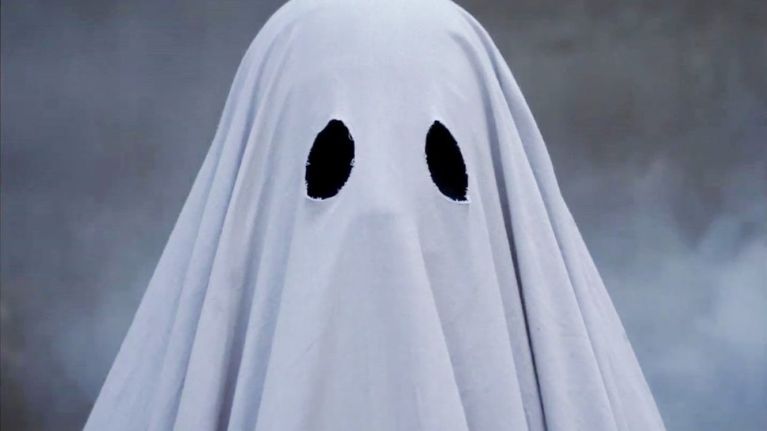Table of Contents
GHOST STORIES FOR MIDDLE-GRADE READERS
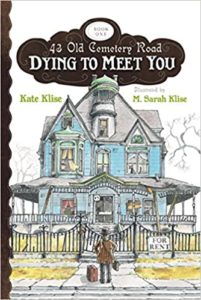 |
In Kate Klise’s Dying to Meet You (Houghton Mifflin Harcourt, 2010), the first of the 43 Old Cemetery Road series, curmudgeonly children’s book writer Ignatius B. Grumply (“specializing in mysteries, mayhem, and the macabre”) rents a run-down Victorian mansion – only to find it already occupied by 11-year-old Seymour Hope, his cat Shadow, and the ghost of failed mystery writer Olive Spence, who lives in the cupola. The story is told in a clever and creative mix of letters, newspaper clippings, and manuscript excerpts. Many sequels. For ages 8-12. |
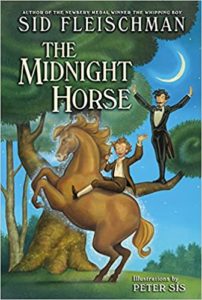 |
In Sid Fleischman’s The Midnight Horse (Greenwillow Books, 2004), it’s a dark and stormy night and the orphan boy, Touch, is en route to meet his evil uncle, Judge Wigglesworth, who is scheming to cheat Touch out of his inheritance. On the way he meets the ghost of the Great Chaffalo, a magician who can turn a heap of straw into a horse – and who becomes Touch’s ally. For ages 8-12. |
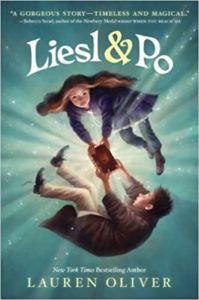 |
In Lauren Oliver’s Liesl and Po (HarperCollins, 2012), Liesl has been locked in the attic by her wicked stepmother after her father’s death. There she is befriended by a little ghost Po – neither male nor female – and Po’s insubstantial pet Bundle, who is not quite a cat and not quite a dog. Po tells Liesl that her dead father needs her help to cross safely to the other side. There’s a mix-up, however, when Will, a miserable alchemist’s apprentice, somehow manages to exchange a box containing the most powerful magic in the world with the box containing Liesl’s father’s ashes. For ages 8-12. |
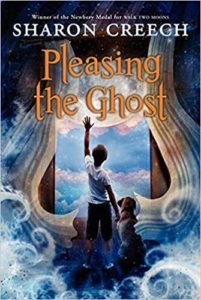 |
In Sharon Creech’s Pleasing the Ghost (HarperCollins, 2013) , nine-year-old Dennis is a basic, ordinary boy – except that, ever since his father died, he sees ghosts. Then the ghost of his Uncle Arvie arrives, sporting a purple sweater and a red cowboy hat – who, having suffered a stroke in real life, now speaks only in gibberrish. Arvie wants Dennis to help widowed Aunt Julia find a hidden stash of treasure, but the search is complicated by Uncle Arvie’s inability to say anything more coherent than “Macaroni dinosaur!” Both funny and sad, as Dennis copes with loss, makes friends with Billy, who has also lost his dad, and does his best to help Arvie. For ages 8-12. |
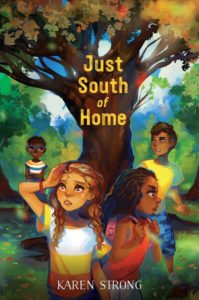 |
Karen Strong’s Just South of Home (Simon & Schuster, 2020), set in Georgia, is a mix of history, mystery, and ghost story. When Sarah’s troublemaking cousin Janie pinches a necklace from the ruins of a black church burned down by the Ku Klux Klan, she stirs up ghosts from the town’s past. An exciting read for ages 8-12. |
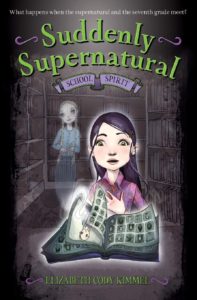 |
The protagonist of Elizabeth Cody Kimmel’s Suddenly Supernatural series (Little, Brown) is young Kat Roberts, whose mother is a spirit-sighting medium – and to her dismay, Kat, at the age of 13, finds that she can see ghosts too. In the first of the four-book series, Suddenly Supernatural: School Spirit (2008), Kat and friend Jac deal with a school haunting. For ages 9-12. |
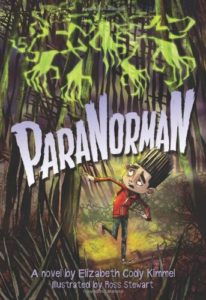 |
In Elizabeth Cody Kimmel’s ParaNorman (Little, Brown, 2013), Norman can see and talk to ghosts, both human and animal. In this, the first book of a series, he encounters a witch who, on the 300th anniversary of her death, is determined to destroy his small New England town. For ages 9-12. |
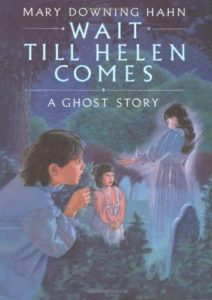 |
Mary Hahn Downing is a ghost story writer extraordinaire. Many satisfyingly spooky titles, among them Wait Till Helen Comes (Houghton Mifflin Harcourt, 2007), The Doll in the Garden (Clarion Books, 2007), The Old Willis Place (Houghton Mifflin Harcourt, 2007), The Ghost of Crutchfeld Hall (Houghton Mifflin Harcourt, 2011), and more. For ages 9-12. |
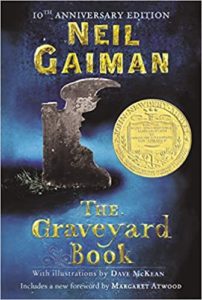 |
In Neil Gaiman’s The Graveyard Book (HarperCollins, 2010), a Newbery winner, Nobody Owens – called Bod – has spent his life in a graveyard, being raised by ghosts (from a range of centuries). The graveyard is a strange and wonderful place – and to leave it puts Bod in danger of Jack, his family’s murderer. For ages 9-12. |
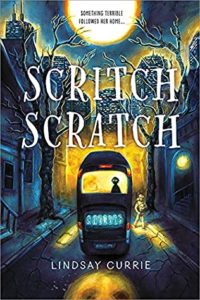 |
In Lindsay Currie’s Scritch Scratch (Sourcebooks, 2020), Claire – a science-loving kid who has nothing but scorn for her father’s ghost-themed Chicago bus tours – gets a shock when she’s suddenly followed by the ghost of a little boy. Then there are strange scratching sounds and the recurring number 396. A spooky history-based ghost story for ages 9-12. |
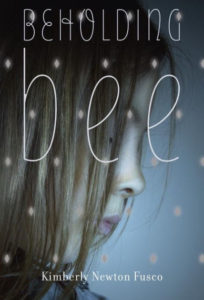 |
Orphaned Bee, the main character of Kimberly Newton Fusco’s Beholding Bee (Knopf, 2013) – mocked because of her diamond-shaped birthmark – helps run the hotdog stand in a 1940s traveling carnival, cared for only by her beloved Pauline. Forcibly separated from Pauline, Bee runs away and ends up living with Mrs. Potter and Mrs. Swift – a pair of feisty elderly ladies who, as it turns out, only Bee can see. With the help of this ghostly pair, Bee ultimately learns to cope with challenges and to value herself – and eventually even to rescue Pauline. For ages 9-12. |
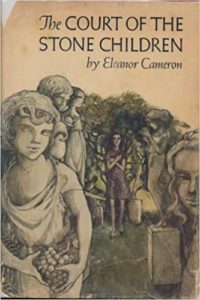 |
In Eleanor Cameron’s The Court of the Stone Children (Puffin, 1990), Nina visits San Francisco’s French Museum and there, in a room from an early 19th-century chateau, meets the ghost of Dominique, whose father was executed in the French Revolution. She needs Nina’s help to prove his innocence. For ages 9-12. |
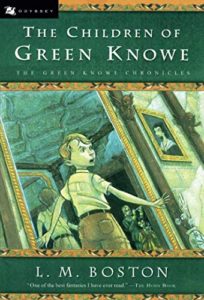 |
L.M. Boston’s The Children of Green Knowe (Houghton Mifflin Harcourt, 2002), originally published in 1954, is the first of a series set in the eerie old English mansion of Green Knowe, where young Tolly comes to live with Mrs. Oldknow, his great-grandmother, who tells wonderful stories of Green Knowe’s past. Characters in this first book include Toby, Alexander, and Linnet – the ghosts of children who lived at Green Knowe in the 17th century – and Green Noah, an evil topiary tree powered by a gypsy curse. Five sequels, all wonderful. For ages 9-12. |
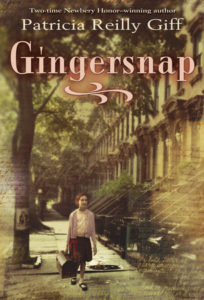 |
In Patricia Reilly Giff’s Gingersnap (Wendy Lamb Books, 2013), set near the end of World War II, Jayna has been left in the care of the landlady while big brother Rob – her only family – is in the navy. When Rob is declared missing in action when his destroyer goes down, Jayna sets off on her own for Brooklyn, hoping to find her grandmother at a bakery called the Gingersnap. She’s armed with an old blue recipe book, accompanied by her pet turtle, Theresa (in a cat carrier), and helped along the way by the voice of a mysterious ghost. (The book includes eight plot-relevant soup recipes.) A brave and heart-warming story for ages 9-12. For more soup resources, including soup stories, soup science, and many great versions of Stone Soup, see Soup. |
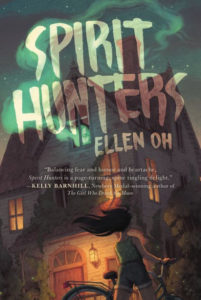 |
In Ellen Oh’s Spirit Hunters (HarperCollins, 2017), Harper and family have just moved to a new house in Washington, DC, that proves to be possessed by an evil spirit. A mystery thriller (with ghosts) for ages 9-12. |
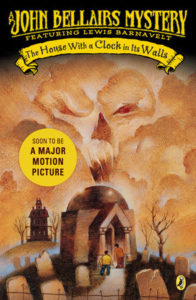 |
In John Bellairs’s The House With a Clock in its Walls (Puffin, 2012), originally published in 1973, orphan Lewis Barnavelt moves to Michigan to live with his Uncle Jonathan – who turns out to be a warlock; and next-door neighbor Florence Zimmerman is a witch. Jonathan’s house was once owned by the evil Isaac and Selena Izard, who hid within its walls a ticking clock capable of bringing about the end of the world. Jonathan and Florence are doing their best to find and disable the clock – a task that becomes more complicated when Lewis and a friend inadvertently raise Selena from the dead on Halloween. There are many more Gothic horror titles for kids by Bellairs, all spooky, addictive, and well done. For ages 9-12. |
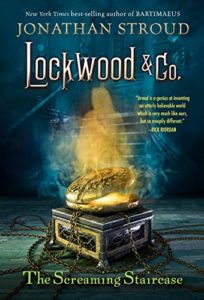 |
In Jonathan Stroud’s Lockwood & Co: The Screaming Staircase (Little, Brown, 2014), the first of a series, London is besieged with ghosts, and Lucy Carlyle and Anthony Lockwood of Lockwood & Co., a kid-run psychic detection agency – armed with iron filings and Greek fire – are investigating haunted houses. Among them the truly terrible Combe Carey Hall. For aged 9-12. |
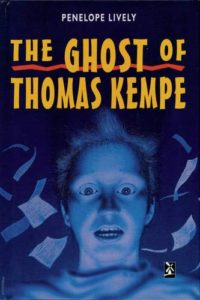 |
In Penelope Lively’s The Ghost of Thomas Kempe (Heinemann, 1975), James’s family have moved to a cottage that proves to be haunted by 17th-century apothecary Thomas Kempe – who wants James for an apprentice. For ages 9-12. |
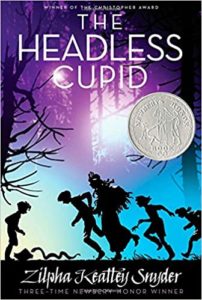 |
In Zilpha Keatley Snyder’s The Headless Cupid (Atheneum, 1971), the Stanley children meet their new stepsister, Amanda – who has a passion for witchcraft and a pet crow. The family house features a cupid on the bannister, reportedly beheaded by a poltergeist in 1896. And then the poltergeist comes back. For ages 9-12. |
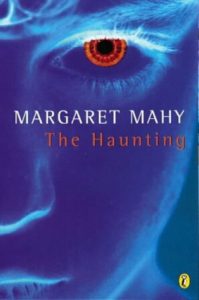 |
In Margaret Mahy’s The Haunting (Atheneum, 1982), eight-year-old Barney is haunted by a strange voice and the apparition of a boy in blue velvet – and discovers that in each generation of his family, one member has supernatural gifts. For ages 9-12. |
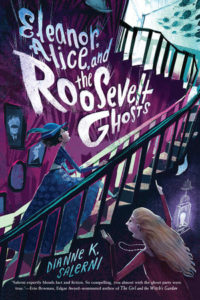 |
By Diane K. Salerni, in Eleanor, Alice, and the Roosevelt Ghosts (Holiday House, 2020), the Roosevelt house is haunted and it’s up to teenaged cousins introverted Eleanor and obstreperous Alice to tackle the ghosts. For ages 9-12. |
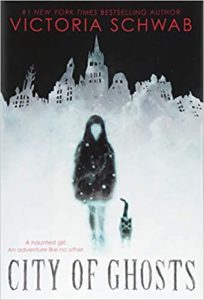 |
In Victoria Schwab’s City of Ghosts (Scholastic, 2019), Cass – whose best friend, Jacob, is a ghost – has the ability to pull back the Veil between the living and the dead. Then her parents, both famed paranormal investigators, have a chance to film a documentary in Edinburgh, Scotland, a ghost-ridden city where Cass meets a girl who shares her ability and runs into danger with a sinister specter known as the Raven in Red. For ages 9-13. |
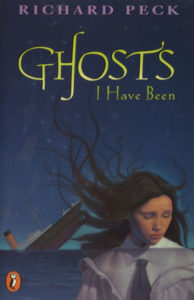 |
In Richard Peck’s Ghosts I Have Been (Puffin, 2001), set in the early 20th century, the snarky and delightful Blossom Culp – who lives with her half-gypsy mother on the wrong side of the railroad tracks – suddenly develops Second Sight. Her first attempt at a séance brings her national notoriety, a friendship with the eccentric Miss Dabney, and a tragic visit to the doomed Titanic, where she is unable to change the course of history. Blossom, believe me, is irresistible. She also appears, still psychic, in The Ghost Belonged to Me and The Dreadful Future of Blossom Culp. For ages 10 and up. |
 |
Katherine Arden’s Dead Voices (Puffin, 2020) is set in a vast and near-empty hotel in the middle of a snowstorm that isolates its residents – including best friends Ollie, Coco, and Brian – from the outside and cuts off the power. And there are ghosts. For ages 10-13. |
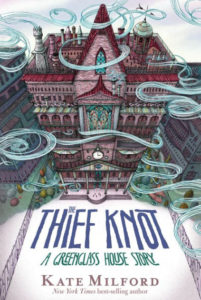 |
By Kate Milford, The Thief Knot (Clarion, 2020), one of the popular Greenglass House series, features a band of creative teens – among them a magician, a code-breaker, and a ghost – who come together to solve a kidnapping. Maps, ciphers, secret tunnels, and the haunted Boneash and Sodalime’s Glass Museum and Radioactive Teashop. A great read for ages 10 and up. |
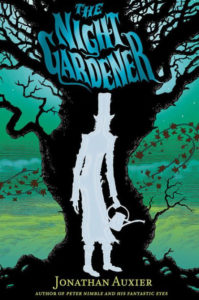 |
Jonathan Auxier’s The Night Gardener (Harry N. Abrams, 2015) is a creepy Victorian ghost story in which Irish orphans Molly and Kip come to work at the Windsor estate, a vast crumbling mansion dominated by an enormous sinister tree, and visited each night by the frightening Night Gardener. For ages 10 and up. |
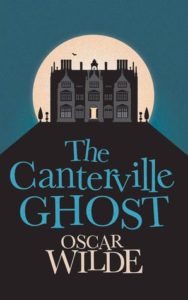 |
In Oscar Wilde’s The Canterville Ghost – available in many editions and as a full text online – the American Hiram B. Otis purchases Canterville Chase, even though everyone tells him that the place is haunted. The obstreperous Otis twins nearly drive the resident Ghost to distraction, though the lovely Virginia, daughter of the family, finally does him a great service. For ages 10 and up. |
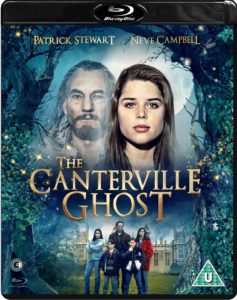 |
A film version of The Canterville Ghost (1996) stars Patrick Stewart as Sir Simon de Canterville (the Ghost). Rated PG. |
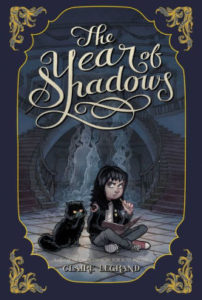 |
In Claire Legrand’s The Year of Shadows (Simon & Schuster, 2013), Olivia’s mother has disappeared and her father’s symphony is going broke, so Olivia, her grandmother, and her father (Olivia calls him the Maestro) move into Emerson Hall, her father’s decrepit concert hall. There Olivia acquires a telepathic cat (Igor, named for Stravinsky) and meets four ghosts who haunt the hall – and who need her help. As Olivia, with the help of her friend Henry, tries to lay the ghosts to rest and save them from invasive malicious shades, she also struggles with family issues and her own unhappiness. A spooky, but ultimately positive, story for ages 10-13. |
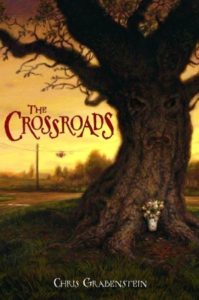 |
In Chris Grabenstein’s The Crossroads (Random House, 2008), eleven-year-old Zack Jennings, his father, and his new stepmother move to Connecticut where their new house stands at a crossroad dominated by an immense tree – the site of a long-ago tragic accident where dozens of people died in an horrific collision. When lightning strikes the tree, the demonic spirit trapped inside it is released and is bent on murderous revenge. Luckily Zack has help from family, friends, and some kindly ghosts. For ages 10-13. |
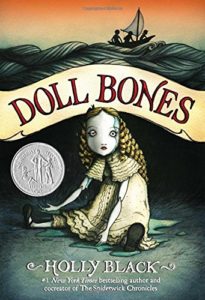 |
In Holly Black’s Doll Bones (Margaret K. McElderry Books, 2013), Zach, Poppy, and Alice end up going on a quest to deal with the demands of a ghost whose bones are encapsulated in a china doll. For ages 10 and up. |
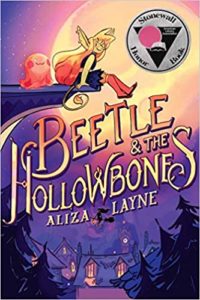 |
In Aliza Layne’s graphic novel Beetle and the Hollowbones (Atheneum, 2020), Beetle, a twelve-year-old goblin-witch, is doing her best to save her best friend, Blob Ghost, from a haunted mall. Things are made more difficult when talented Kat returns to town as an apprentice to the villainous sorceress Aunt Hollowbones. For ages 10 and up. |
GHOST STORIES FOR OLDER READERS
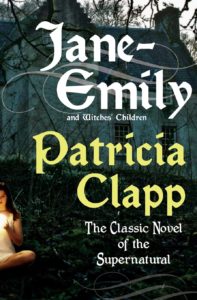 |
In Patricia Clapp’s Jane-Emily (HarperCollins, 2009), Emily – an evil child – died many years ago before her thirteenth birthday. Now nine-year-old Jane and her Aunt Louisa have come to spend the summer at Jane’s grandmother’s house – and there Jane first sees Emily, staring back at her from the reflecting ball in the garden. A Gothic thriller for ages 12 and up. |
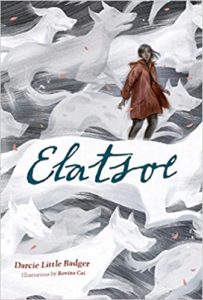 |
By Darcie Little Badger, Elatsoe (Levine Querido, 2020) is a supernature murder mystery in which Elatsoe (called Ellie), a 17-year-old Lipan Apache with a talent for ghost calling, her spectral dog Kirby, and best friend Jay (a descendant of the fairy king Oberon) join forces to track down a murderer. For ages 12 and up. |
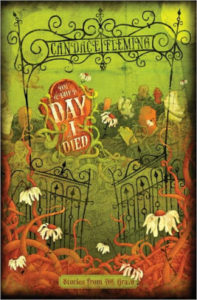 |
Candace Fleming’s On the Day I Died: Stories from the Grave (Schwartz & Wade, 2012) begins when young Mike Kowalski picks up a drenched young girl on the side of a country road in the middle of the night who begs for a ride home. She leaves her saddle shoes behind in his car, and when Mike tries to return them, he finds that the girl – Carol Anne – drowned sixty years ago. When he visits the graveyard, he finds himself surrounded by young ghosts from the 1860s on who insist on taking turns to tell the stories of their deaths. Nicely creepy for ages 12 and up. |
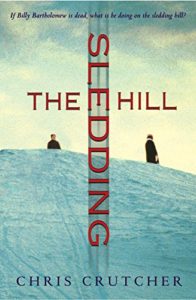 |
Chris Crutcher’s The Sledding Hill (Greenwillow Books, 2006) is narrated by the ghost of Billy Bartholomew, best friend of Eddie Profitt, who has stopped talking following the deaths of both Billy and his father. Eddie’s mother copes by joining the fundamentalist church of the Reverend Tarter, a teacher at the high school, who attempts to ban a book, Warren Peace, by (I wish the author hadn’t done this) a writer named Chris Crutcher. Eddie finally finds his voice again, defending the book. A lot of possibility for discussion here for ages 12 and up. |
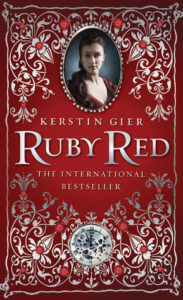 |
In Kerstin Gier’s Ruby Red (Square Fish, 2012), young Gwyneth Shepherd discovers that she, and not as expected her sophisticated cousin Charlotte, has inherited the family time-travel gene. Gwyneth also has a special talent all her own: she can see ghosts. The first of a terrific trilogy, set in Britain. Subsequent titles are Sapphire Blue and Emerald Green. (These are good. Don’t be fooled by the covers, which make them look like bodice rippers.) For ages 12 and up. |
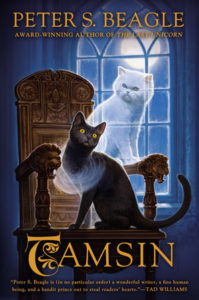 |
In Peter S. Beagle’s Tamsin (NAL, 2013), 13-year-old Jenny Gluckstein moves from New York to Stourhead Farm in Dorset, England with her mother, her new stepfather, and his sons. There she meets to ghost of Tamsin who – along with her cat – has haunted the farm for 300 years, trapped there by a trauma that she can’t bring herself to remember. Wonderful slices of English history and folklore. For ages 12 and up. |
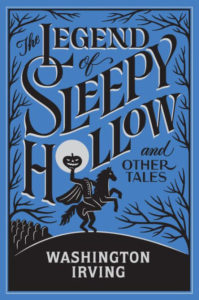 |
In Washington Irving’s The Legend of Sleepy Hollow – originally published in 1820 and now available in many editions – the most famous specter in the little Dutch town of Sleepy Hollow is the Headless Horseman, said to be the ghost of a Hessian soldier who had his head shot off in the Revolutionary War. The plot involves the competition of gawky schoolmaster Ichabod Crane and popular local boy Brom Bones for the hand of lovely Katrina Van Tassel, and a trick on horseback with a pumpkin. The full text of the story is online here. A film version of the story, Sleepy Hollow, with Johnny Depp as Ichabod Crane, is rated R. NOT for little guys. |
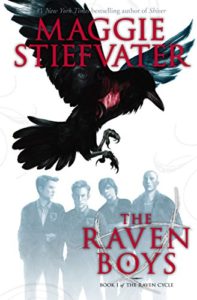 |
In Maggie Stiefvater’s The Raven Boys (Scholastic, 2013), teenaged Blue and her psychic mother wait at the churchyard each St. Mark’s Eve to see the spirits of those who will die within the next year. This particular spring Blue sees the shade of Gansey, one of the privileged Raven Boys from Aglionby Academy. Several sequels. For ages 13 and up. |
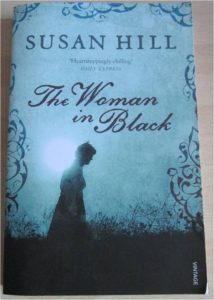 |
Susan Hill’s The Woman in Black (Vintage, 2012) is a creepy and classic ghost story, set in a small English town at the fog-ridden Eel Marsh House. Eerie and psychologically compelling, unlike the awful movie. For teens and adults. |
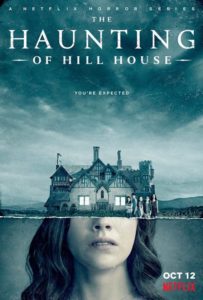 |
Shirley Jackson is brilliant. In The Haunting of Hill House (Penguin Classics, 2006), originally published in 1959, main character Eleanor Vance – due to a paranormal event in her childhood – is invited to participate in an investigation of supernatural happenings at the chillingly disturbing Hill House. Subtle, fascinating, and psychologically twisty. For older teenagers and adults. |
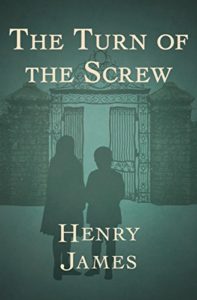 |
In Henry James’s classic ghost story novella, The Turn of the Screw – available in many editions – a horrified governess discovers that she’s not just dealing with her young charges, but with ghosts. For teens and adults. The full text of The Turn of the Screw is available online from Project Gutenberg. The Turn of the Screw (1999) is a British made-for-TV version, which aired on PBS’s Masterpiece Theatre. |
 |
Alice Sebold’s The Lovely Bones (Little, Brown, 2002) is a painful story told entirely from the point of view of a ghost: 14-year-old Susie Salmon, murdered by a neighborhood serial killer, who now watches from the afterlife the experiences of family, friends, and her killer. For teens and adults. The film version of The Lovely Bones is rated PG-13. |
